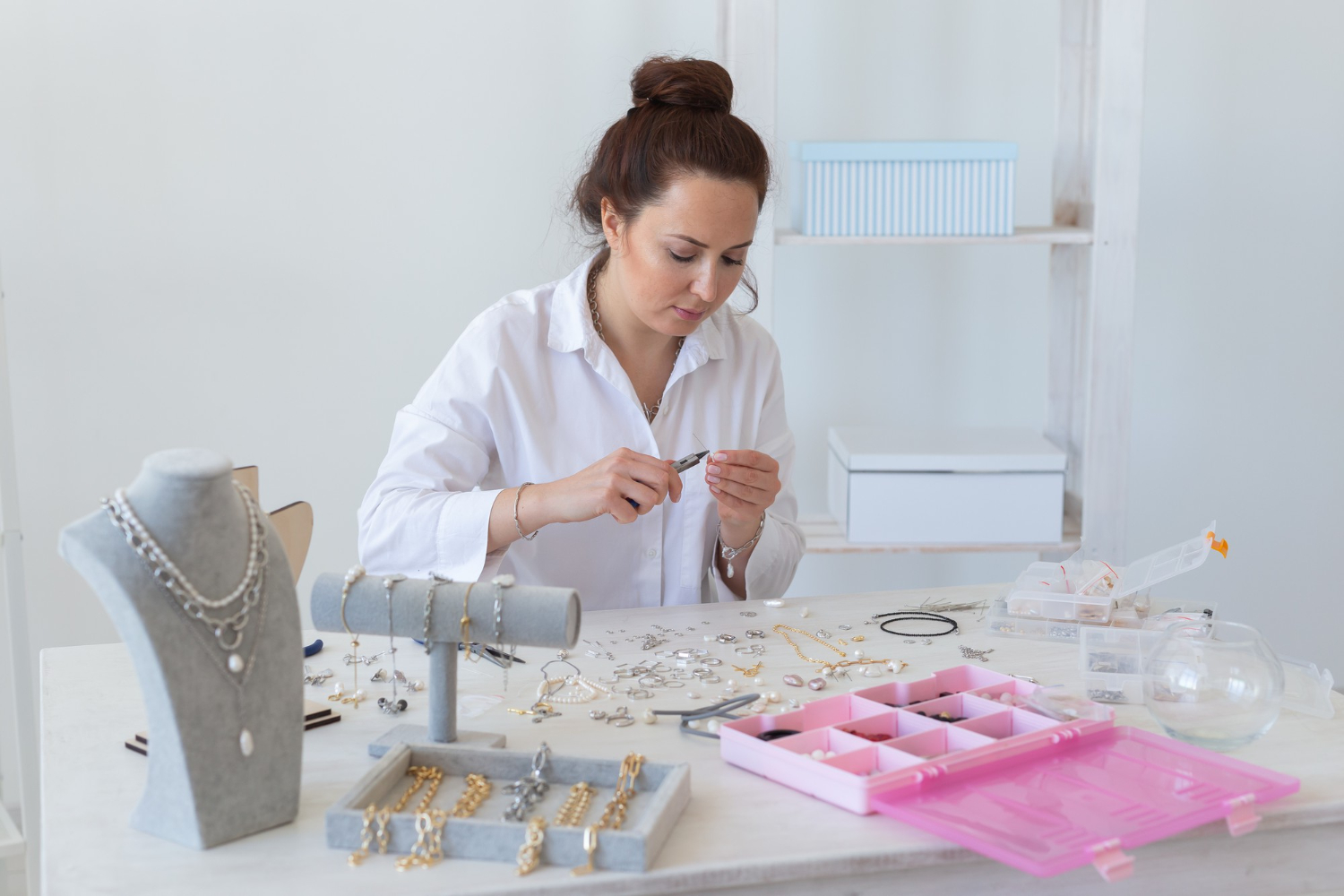Designer jewelry represents a blend of art and craftsmanship that has captivated people for centuries. This type of jewelry is distinguished by its unique designs, high-quality materials, and the expertise involved in its creation. From engagement rings to statement pieces, designer jewelry often carries significant meaning and is crafted to last a lifetime.
With brands like Tiffany & Co. and David Yurman leading the market, the appeal of luxury jewelry is stronger than ever. Not only does it serve as a fashion accessory, but it also acts as a symbol of status and personal expression. Collecting designer jewelry can be both an investment and a way to celebrate life’s memorable moments.
Understanding the world of designer jewelry encompasses its history, the materials used, and current trends that shape its market. Whether considering a purchase or simply appreciating the art form, a deeper look can enhance one’s appreciation for these iconic creations.
Key Takeaways of Designer Jewelry
- Designer jewelry combines art with skilled craftsmanship.
- Luxury brands often influence current fashion trends.
- Investing in designer pieces can have long-term value.
History of Designer Jewelry
Designer jewelry has a rich and varied history that showcases both artistry and craftsmanship. It has evolved from ancient adornments to the luxe pieces seen today. This section explores its origins, notable designers, and styles that have defined eras.
Origins and Evolution
Jewelry design can be traced back at least 7,000 years to ancient civilizations like those in Mesopotamia and the Indus Valley. Initial pieces were often simple, made from natural materials such as shells, stones, and bones.
As time progressed, metals like gold and silver became popular. These materials signified wealth and status. Burying the dead with valuable items became common, highlighting the importance of jewelry in cultural rituals.
By the Middle Ages, jewelry evolved into more intricate designs, often featuring gemstones. The Renaissance period marked a surge in creativity, with pieces showcasing artisans’ skills. This shift set the foundation for what would become designer jewelry.
Iconic Jewelry Designers
Several designers have left a lasting mark on the jewelry world. Names like Coco Chanel, Cartier, and Tiffany & Co. are just a few that revolutionized the field.
Coco Chanel introduced costume jewelry, making luxury accessible to more people. Cartier is known for its signature styles and innovations, like the use of the “Tutti Frutti” design, blending colorful gemstones.
Tiffany & Co. popularized high-quality diamonds and unique settings. Each designer contributed distinct aesthetics, often influenced by historical events or personal experiences. Their works remain timeless and are often sought after by collectors.
Era-Defining Styles
Each era has produced unique jewelry styles, reflecting cultural shifts and technological advancements.
In the Victorian era, mourning jewelry became popular, often featuring dark gemstones like onyx and jet.
The Art Nouveau movement introduced nature-inspired designs, emphasizing flowing lines and organic forms.
The Art Deco period was marked by bold geometric shapes and bright colors. It showcased a modern spirit, moving away from the intricate styles of the past.
In the late 20th century, designer jewelry took another turn with minimalism, focusing on sleek designs and understated elegance. Each style tells a story of its time and continues to influence designers today.
Materials and Craftsmanship
Designer jewelry is defined by its quality materials and skilled craftsmanship. The use of precious metals, exquisite gemstones, and specialized handcrafting techniques all contribute to the unique appeal of each piece.
Precious Metals
Precious metals form the backbone of designer jewelry. Common choices include gold, silver, and platinum. Each metal has distinct properties that affect durability, weight, and appearance.
- Gold: Available in various karats, the purity level influences color and value. Yellow, white, and rose gold are popular variations.
- Silver: Sterling silver, made of 92.5% silver, is favored for its affordability and sheen.
- Platinum: Known for its strength and resistance to tarnish, platinum is often used in high-end pieces.
Jewelry designers select metals based on their aesthetic qualities and the intended use of the piece.
Gemstones and Diamonds
Gemstones and diamonds play a crucial role in enhancing the beauty of jewelry. They add color, sparkle, and an emotional resonance that connects with the wearer.
- Gemstones: Sapphires, rubies, and emeralds are examples of popular choices. Each has its own unique hue and symbolism.
- Diamonds: Valued for their brilliance and hardness, diamonds are often the centerpiece in engagement rings and luxury items. The Four Cs (cut, color, clarity, and carat weight) determine their value.
Each gemstone is carefully sourced and selected to ensure quality and alignment with the overall design.
Handcrafting Techniques
Handcrafting ensures that each jewelry piece tells its own story. Various techniques enhance the craftsmanship and uniqueness of designer items.
- Casting: This involves pouring molten metal into a mold to create a specific shape, allowing intricate designs.
- Stone Setting: Skilled artisans use techniques like prong setting or bezel setting to secure gemstones in place.
- Engraving and Etching: These methods allow for unique designs or personal messages to be added to jewelry.
Through these methods, artisans pour their creativity and skill into every piece, resulting in jewelry that is not only visually stunning but also holds significant value.
Design Principles in Fine Jewelry
Design principles are essential in creating fine jewelry that is visually appealing and effectively conveys the designer’s vision. Concepts like balance, symmetry, and color theory greatly influence how pieces are perceived and appreciated.
Balance and Proportion
Balance refers to how the various elements of a jewelry piece are arranged. It ensures that no one part of the design overwhelms another. Designers often use two types of balance: symmetrical and asymmetrical. Symmetrical designs are mirrored, creating harmony. Asymmetrical designs, while seemingly unbalanced, can create visual interest.
Proportion relates to the size and scale of the jewelry elements. A small pendant on a long chain can create elegance, while large earrings can make a bold statement. Proper proportion ensures the piece feels cohesive, allowing each component to complement the others without competing for attention.
Symmetry and Asymmetry
Symmetry is a traditional principle often favored in jewelry design. It provides a sense of stability and order. For example, a pair of earrings that mirror each other can create a classic look.
Conversely, asymmetry can add excitement and modern appeal. Designers often place an uneven number of gemstones or vary the lengths of chains to generate interest. This approach can lead to a more dynamic and contemporary feel while still maintaining balance, ensuring that the overall aesthetic is visually pleasing.
Color Theory in Jewelry Design
Color theory plays a critical role in the effectiveness of jewelry design. Understanding color combinations can enhance the appeal of a piece. For instance, complementary colors—such as blue and orange—can make elements pop against each other, attracting the eye.
Designers often consider the emotional responses associated with colors. Warm colors, like reds and yellows, may evoke feelings of energy and passion. Cool colors, such as blues and greens, tend to project calmness. By thoughtfully applying color theory, designers can create pieces that resonate with wearers on a deeper level.
Through these principles, jewelry designers can craft pieces that are not only beautiful but also conceptually strong, enhancing both the artistry and the experience of the jewelry.
Current Trends in Designer Jewelry
Designer jewelry is evolving to reflect modern values and technological advances. Key trends include a focus on sustainability and ethics, innovative use of technology, and the growing influence of pop culture.
Sustainable and Ethical Practices
Many designers prioritize sustainability in their work. They choose materials that are ethically sourced and environmentally friendly. This includes recycled metals and lab-grown stones.
Brands like Stella McCartney lead the way by using vegan materials. Transparency in sourcing is crucial; customers want to know the origin of their jewelry. This demand encourages designers to share their practices openly.
Additionally, upcycled jewelry is gaining popularity. This style involves transforming old pieces into unique, new creations. Such practices not only reduce waste but also appeal to consumers looking for one-of-a-kind items.
Technology and Innovation
Technology is reshaping how jewelry is designed and made. 3D printing is one of the most significant advancements. It allows for intricate designs that were previously hard or expensive to achieve.
Many designers are experimenting with smart jewelry. This includes pieces that can track health metrics or connect to devices. It blends fashion with functionality, appealing to tech-savvy consumers.
Augmented reality (AR) is also being used for virtual try-ons. This technology helps customers visualize how a piece will look before they buy it, enhancing the shopping experience.
Influence of Pop Culture
Pop culture heavily impacts designer jewelry trends. Celebrity endorsements and appearances at major events drive demand for specific styles. For instance, pieces worn by stars at the Oscars can lead to sells outs within hours.
Social media plays a key role in this influence. Platforms like Instagram and TikTok showcase unique designs and trends. Influencers often set trends by pairing popular styles with everyday outfits.
Certain motifs, such as stars or butterflies, have surged in popularity due to their representation in popular films and music. This connection between culture and jewelry keeps styles fresh and relevant.
Acquiring Designer Jewelry
Designer jewelry is a unique investment that reflects a blend of artistry and craftsmanship. When acquiring such pieces, it’s essential to consider the right selection, ensure authenticity, and practice proper care and maintenance.
Choosing the Right Piece
Selecting the perfect designer jewelry involves personal taste and style. Individuals should first identify their preferences, such as the type of jewelry they seek, whether it is earrings, necklaces, or bracelets.
Next, consider the occasion. Is it a daily accessory, a gift, or for a special event? Setting a budget is crucial too. Design options can range from affordable brands to high-end luxury pieces. A well-curated collection can enhance any wardrobe.
Also, consider the designer’s heritage and reputation. Well-known designers often have a legacy of quality, which can increase a piece’s desirability over time.
Authenticity and Value
Authenticity is critical when acquiring designer jewelry. Buyers should seek reputable dealers and retailers who provide certificates of authenticity.
Some well-known features of authentic pieces include:
- Hallmarks: Manufacturer’s stamp indicating quality and origin.
- Materials: Use of genuine materials like gold, silver, or precious stones.
- Packaging: Original boxes and documents often add value.
Investing in designer jewelry can offer financial returns if the piece retains its value. It is wise to research market trends and understand how certain pieces may appreciate or depreciate over time.
Care and Maintenance
Proper care extends the life of designer jewelry. Regular cleaning is essential, as dirt and oils can dull the finish. Soft, lint-free cloths work best for wiping down pieces.
Here are some care tips:
- Storage: Keep jewelry in a cool, dry place. Use pouches or cases to avoid scratches.
- Avoid Exposure: Limit wear during activities that can cause damage, such as swimming or exercising.
- Professional Cleaning: Regularly schedule deep cleaning with a professional to maintain shine and integrity.
By following these guidelines, individuals can enjoy their designer jewelry for years while preserving its beauty and value.



